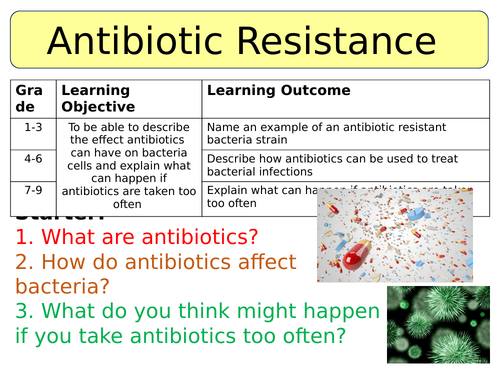
This is a resource aimed at the NEW AQA GCSE Biology specification, developed to meet learning outcomes within the 'Infection & Response' unit.
This lesson is part of a 12 lesson bundle for the NEW 'Infection & Response' Unit, found in my TES shop: https://www.tes.com/teaching-resources/shop/SWiftScience
The lesson begins by describing the process by which a bacteria may become resistant to an antibiotic.
Pupils will then watch a storyboard animation which demonstrates this process visually. Pupils can then use this animation to create their own storyboard, including diagrams and captions, to represent the process of natural selection in bacteria which leads to antibiotic resistance.
The focus of the lesson is then on MRSA, a few real-life headlines are given as an example of an antibiotic resistant bacteria. Pupils will brainstorm what sorts of methods hospitals employ to reduce the spread of such 'super bugs'.
The final activity is for pupils to completed questions on antibiotic resistance and how to prevent the spread of antibiotic resistant bacteria such as MRSA. The mark scheme for the questions are included on the Power Point presentation for students to mark their own work or peer-assess.
The plenary is a recap on the learning outcomes, pupils will need to assess whether they are R/A/G.
This lesson is part of a 12 lesson bundle for the NEW 'Infection & Response' Unit, found in my TES shop: https://www.tes.com/teaching-resources/shop/SWiftScience
The lesson begins by describing the process by which a bacteria may become resistant to an antibiotic.
Pupils will then watch a storyboard animation which demonstrates this process visually. Pupils can then use this animation to create their own storyboard, including diagrams and captions, to represent the process of natural selection in bacteria which leads to antibiotic resistance.
The focus of the lesson is then on MRSA, a few real-life headlines are given as an example of an antibiotic resistant bacteria. Pupils will brainstorm what sorts of methods hospitals employ to reduce the spread of such 'super bugs'.
The final activity is for pupils to completed questions on antibiotic resistance and how to prevent the spread of antibiotic resistant bacteria such as MRSA. The mark scheme for the questions are included on the Power Point presentation for students to mark their own work or peer-assess.
The plenary is a recap on the learning outcomes, pupils will need to assess whether they are R/A/G.
Get this resource as part of a bundle and save up to 45%
A bundle is a package of resources grouped together to teach a particular topic, or a series of lessons, in one place.
Something went wrong, please try again later.
Report this resourceto let us know if it violates our terms and conditions.
Our customer service team will review your report and will be in touch.
£2.00
